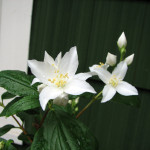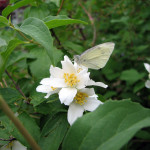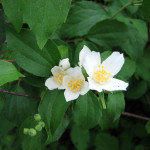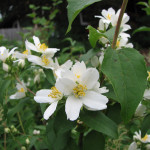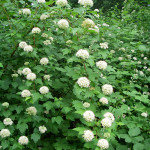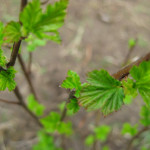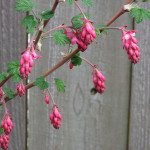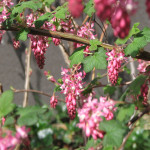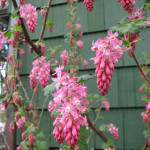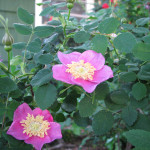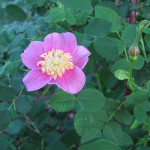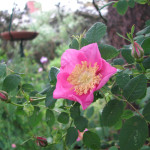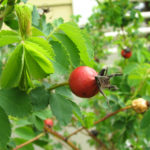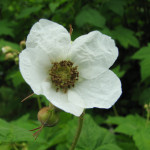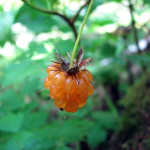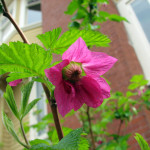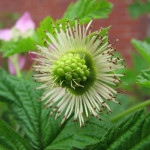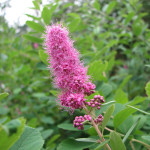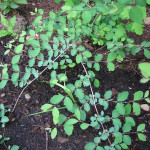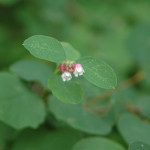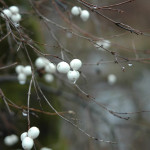Philadelphus lewisii
Mockorange (Philadelphus lewisii) is an elegant native shrub which grows 3-9 feet tall and has a rounded form. The long stems are red when new and fade to gray with age, the older bark shredding in small flakes. Leaves are usually oval, 1-2 inches long, and a medium green.
White flowers start appearing in clusters at the ends of stems after the plant is 3-4 years old. At the height of bloom, older plants are covered in masses of sweet-smelling flowers, which have a scent similar to orange blossoms with a hint of pineapple.
This plant is as popular with wildlife as it is with people. The indra and pale swallowtail butterflies visit it for nectar, as do hummingbirds and many other pollinators. Tiger swallowtails lay their eggs on it. Birds and small mammals eat the seeds and shelter in the foliage.
Mock-orange’s green leaves turn soft yellow in autumn, contrasting beautifully with the dark green of of evergreen huckleberry and red fall foliage of Western viburnum. Add an understory of sword fern for year-round beauty and wildlife value!
- Light Requirements: Full Sun, Part Shade, Full Shade
- Water Requirements: Dry, Moist
- Ease of Growing: Easy to grow
- Growth Rate: Fast
- Spreads:
- Wildlife Support: Pollinators, Pest-eating Insects, Birds or Mammals
- Fire-resistant: Yes
- Edible: No
- Mature Height: 6-10ft
- Mature Width:4-10ft
Pacific Ninebark
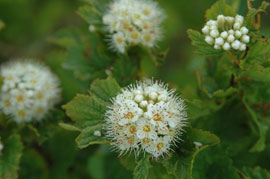
Physocarpus capitatus
Pacific ninebark (Physocarpus capitatus) is a dense deciduous shrub growing up to 12 feet tall. The name refers to the unusual bark, which naturally peels off in many colorful layers.
The shrub has maple-like lobed leaves and attractive clusters of small white flowers in May and June. The unique fruit is a glossy red pod which turns dry and brown, and then splits open to release seeds.
The twigs, berries, buds, and leaves are all browsed by wildlife. Pacific ninebark is very important for pollinators, especially solitary bees who lay their eggs and take shelter for the winter in the hollow stems. Pacific ninebark is also a food source for the young of spring azure butterflies, and many birds use it for nesting.
It is often found in wetlands, but also forms thickets along rivers and in moist forest habitats. It can also tolerate some drought. Create a dense deciduous screen by growing it in combination with oceanspray and Douglas spirea. Best in full sun to part shade.
- Light Requirements: Part Shade
- Water Requirements: Moist, Seasonally Wet
- Ease of Growing: Easy to grow
- Growth Rate: Fast
- Spreads: Yes
- Wildlife Support: Pollinators, Pest-eating Insects, Birds or Mammals
- Fire-resistant: Yes
- Edible: No
- Mature Height: 8-12ft
- Mature Width:4-7ft
Red Flowering Currant
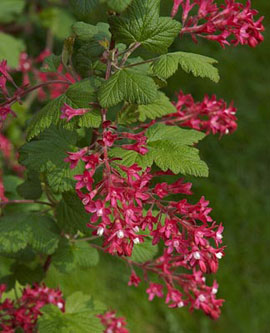
Ribes sanguineum var. sanguineum
Red flowering currant (Ribes sanguineum) is an upright, multi-stemmed deciduous shrub that can get 6-10 feet tall, and is considered one of our prettiest native shrubs. Its bright pink, dangling flower clusters in late February and March are welcome signs of spring!
The bark is dark brownish-grey with pale brown lenticels. The palmate leaves have five lobes, and young leaves and flowers have a scent variously described as spicy or resinous. The fruits form as clusters of dark purple berries which contrast beautifully with the rosy gold fall foliage.
Keep a pair of binoculars handy if you plant this lovely shrub, because red flowering currant is a favorite of hummingbirds and other wildlife all year long. The flowers are important early spring nectar sources for rufous and Anna’s hummingbirds, spring azure and mourning cloak butterflies, and many native bees. Many birds eat the berries in the fall and winter, including towhees, thrushes, cedar waxwings, and sparrows. This charming plant also hosts the eggs of zephyr butterflies, and provides shelter for songbirds.
Red flowering currant can tolerate shade, but grows best (and blooms the most) in sunny locations with well drained soils.
- Light Requirements: Full Sun, Part Shade
- Water Requirements: Dry, Moist
- Ease of Growing: Easy to grow
- Growth Rate: Fast
- Spreads:
- Wildlife Support: Pollinators, Hummingbirds, Pest-eating Insects, Birds or Mammals
- Fire-resistant: Yes
- Edible: Yes
- Mature Height: 4-10ft
- Mature Width:3-10ft
Nootka Rose
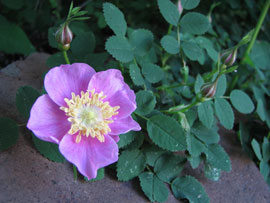
Rosa nutkana var. nutkana
The Nootka rose is an attractive shrub growing up to 9′ high. The straight, erect stems are usually green, but occasionally may be reddish. The prickles are larger and thicker than those of the other native rose species.
The leaves are alternate on the stems and pinnately compound with 5-7 leaflets, dark green above, paler and slightly hairy below. The leaflets are elliptic or ovate in shape with serrate margins, and range from 1-7 cm long and 0.7-4.5 cm wide.
The sweet-scented, pink flowers are usually solitary, occasionally growing in groups of 2 or 3. They are large and showy, ranging from 5-8 cm across. Individual petals are 2.5-4 cm long, and 5 petals are the norm for the flowers. The rose hips are spherical, orange-red and large, ranging from 1-2 cm wide.
Uses
Wild rose is spindly and tends to form loose thickets, which in large spaces makes it useful as a hedgerow or as a wildlife-friendly ornamental. The leaves and fruits are important food sources for herbivores and upland game birds, and rose thickets provide excellent nesting and escape habitat for songbirds. The plant also has many traditional uses in Native American culture. Rose hips can be made into jam, tea, and used as flavoring, and the leaves have a variety of medicinal uses. Dried flower petals are used for scents and potpourri.
Habitat
Nootka rose may be found in open upland woods or in open shrub wetlands. In areas where both Rosa nutkana and Rosa woodsii occur, the former may be found at higher elevations and often in woods.
- Light Requirements: Full Sun, Part Shade
- Water Requirements: Dry, Moist, Seasonally Wet
- Ease of Growing: Easy to grow
- Growth Rate: Moderate
- Spreads: Yes
- Wildlife Support: Pollinators, Pest-eating Insects, Birds or Mammals
- Fire-resistant: Yes
- Edible: Yes
- Mature Height: 6-10ft
- Mature Width:3-4ft
Thimbleberry

Rubus parviflorus
Thimbleberry (Rubus parviflorusis) is a dense, spreading deciduous shrub that grows 4-6 feet tall and wide. It is a friendly plant with large, soft, fuzzy leaves and no thorns or prickles. The white flowers have five petals and a pale yellow center. The delicious fruits are like large, soft, velvety raspberries.
Thimbleberries are used by many kinds of wildlife year round. They are important sources of nectar, nest material, and winter shelter for native bees. Yellow-banded sphinx moths eat the leaves when young, and the berries are eaten by dozens of species.
These thicket-forming plants typically grow along roadsides, railroad tracks, and in forest clearings, commonly appearing soon after clear cuts and forest fire areas. In urban areas, thimbleberries can form a natural hedge at the back of the garden or provide cover on sunny, dry hillsides.
- Light Requirements: Full Sun, Part Shade, Full Shade
- Water Requirements: Dry, Moist
- Ease of Growing: Easy to grow
- Growth Rate: Moderate
- Spreads: Yes
- Wildlife Support: Pollinators, Hummingbirds, Pest-eating Insects, Birds or Mammals
- Fire-resistant: No
- Edible: Yes
- Mature Height: 4-6ft
- Mature Width:3-6ft
Salmonberry

Rubus spectabilis
Salmonberry (Rubus spectabilis) is an upright shrub growing to 10 feet tall, with a unique vase-like shape and prickly stems. The purple-magenta flowers bloom April through June. The orange-red, raspberry-like fruit matures in late summer to early autumn.
Salmonberry is a great wildlife plant for a large yard or garden; the open flowers attract bumblebees and hummingbirds while the fruit is a treat for thrushes, tanagers, finches, and wrens. Native bees also use it extensively for nesting material and winter shelter.
Salmonberries grow in moist forest openings and stream margins, so it does best in full sun to part shade and moist to wet soils. They often form large thickets, and thrive in the open spaces under stands of red alder.
- Light Requirements: Full Sun, Part Shade, Full Shade
- Water Requirements: Moist, Seasonally Wet
- Ease of Growing: Easy to grow
- Growth Rate: Moderate
- Spreads: Yes
- Wildlife Support: Pollinators, Hummingbirds, Pest-eating Insects, Birds or Mammals
- Fire-resistant: No
- Edible: Yes
- Mature Height: 4-10ft
- Mature Width:4-10ft
Douglas Spirea
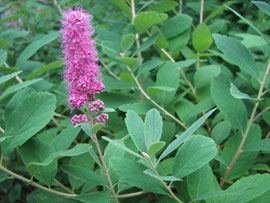
Spiraea douglasii
Also known as hardhack or steeplebush, Douglas spirea (Spiraea douglasii) is best known for its large, pink, pointy clusters of small flowers that bloom from May – July. The flower clusters turn dark in late summer and linger on the plant for months, adding visual interest.
A fast grower that can reach 10-12 feet tall in just a few years, Douglas spirea favors open sunny areas and can tolerate seasonal flooding. It can spread aggressively in moist environments, but is better behaved in drier areas.
Many butterflies visit this plant for nectar and lay their eggs on it, including pale swallowtail, Lorquin’s admiral, spring azure, and mourning cloak.
- Light Requirements: Full Sun, Part Shade
- Water Requirements: Moist, Seasonally Wet
- Ease of Growing: Easy to grow
- Growth Rate: Fast
- Spreads: Yes
- Wildlife Support: Pollinators, Pest-eating Insects, Birds or Mammals
- Fire-resistant: Yes
- Edible: No
- Mature Height: 6ft
- Mature Width:3-7ft
Snowberry
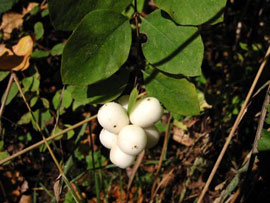
Symphoricarpos albus
Few plants are as aptly named as snowberry. Small bell-like pink flowers give way to scattered clusters of white berries in late summer, which stay on the delicate, arching branches through the fall and much of winter. The small, pale green oval leaves turn a soft yellow in the fall.
Snowberries are at their best in the landscape when combined with other plants. They bring an airy lightness to the understory that contrasts well with the thick evergreen leaves of salal and low Oregon grape, the red stems of red osier dogwoods, and the feathery green foliage of Western hemlock and Western redcedar.
The berries are eaten late in winter by thrushes, towhees, robins, waxwings, and grosbeaks. Anna’s and rufous hummingbirds are attracted to the flowers, as are many species of native bees. Snowberry also provides food for the young of vashti sphinx moths and is generally good cover for wildlife.
Snowberry is tolerant of a wide variety of growing conditions, spreads easily, and makes an excellent addition to any garden.
- Light Requirements: Full Sun, Part Shade, Full Shade
- Water Requirements: Dry, Moist
- Ease of Growing: Easy to grow
- Growth Rate: Fast
- Spreads: Yes
- Wildlife Support: Pollinators, Hummingbirds, Pest-eating Insects, Birds or Mammals
- Fire-resistant: Yes
- Edible: No
- Mature Height: 3-6ft
- Mature Width:2-4ft


